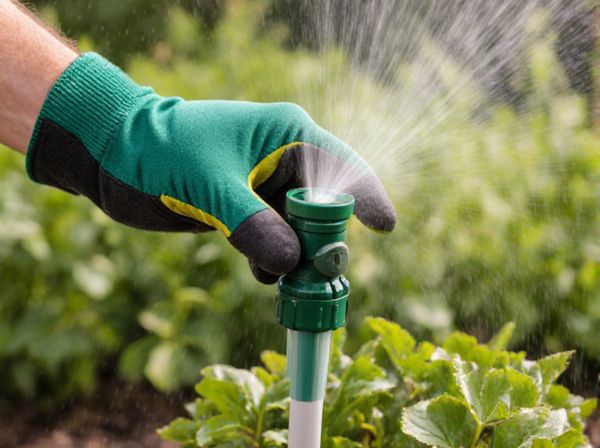
Drip Irrigation vs Overhead Irrigation Illustration
Drip irrigation delivers water directly to the plant roots, minimizing evaporation and conserving water while promoting healthier plant growth. Overhead irrigation sprays water over the entire plant, often causing water loss through evaporation and increasing the risk of fungal diseases. Choosing drip irrigation over overhead systems supports sustainable organic farming by improving water efficiency and reducing disease incidence.
Table of Comparison
| Feature | Drip Irrigation | Overhead Irrigation |
|---|---|---|
| Water Efficiency | High - minimizes evaporation and runoff | Low - prone to evaporation and wind drift |
| Organic Crop Suitability | Excellent - reduces disease by limiting leaf wetness | Moderate - can increase fungal diseases due to wet foliage |
| Water Usage | Low - targeted water delivery | High - covers larger area indiscriminately |
| Installation Cost | Moderate to high - requires setup of pipes and emitters | Low - simpler infrastructure |
| Maintenance | Moderate - requires regular emitter cleaning | Low - less prone to clogging |
| Weed Growth | Reduced - water delivered directly to roots | Increased - water covers entire soil surface |
| Crop Yield Impact | Positive - consistent moisture improves growth | Variable - depends on weather and water distribution |
Introduction to Drip and Overhead Irrigation Methods
Drip irrigation delivers water directly to plant roots through a network of tubes and emitters, optimizing water use efficiency and minimizing evaporation and runoff. Overhead irrigation distributes water over the crop canopy using sprinklers or spray heads, covering large areas but often resulting in higher water loss due to evaporation and wind drift. Both methods serve different agricultural needs, with drip irrigation favored for targeted watering and water conservation, while overhead irrigation suits broader coverage in diverse crop systems.
How Drip Irrigation Works in Organic Gardening
Drip irrigation delivers water directly to the root zone through a network of tubes and emitters, minimizing water waste and reducing soil erosion in organic gardening. This targeted watering method supports healthier plant growth by maintaining consistent soil moisture levels and limiting weed proliferation. Its efficiency enhances nutrient absorption and microbial activity crucial for organic soil health.
Overhead Irrigation: Principles and Practices
Overhead irrigation disperses water through a system of pipes and sprinklers positioned above crops, mimicking natural rainfall to ensure uniform coverage across fields. It is widely used in organic farming to maintain soil moisture without soil compaction, while supporting plant health by reducing water stress and nutrient leaching. Effective management involves scheduling irrigation based on weather conditions and crop water requirements to optimize water use efficiency and minimize disease risk.
Water Efficiency Comparison: Drip vs Overhead
Drip irrigation delivers water directly to plant roots, reducing evaporation and runoff, which increases water efficiency by up to 90% compared to overhead irrigation. Overhead irrigation methods, such as sprinklers, often result in significant water loss due to wind drift and evaporation, with efficiency rates typically around 50-60%. Studies show drip systems conserve water by targeting specific zones, optimizing soil moisture levels and promoting healthier plant growth in organic farming.
Soil Health Impacts in Organic Gardens
Drip irrigation delivers water directly to the root zone, minimizing soil erosion and reducing nutrient leaching in organic gardens, which preserves soil microbiota essential for healthy plant growth. Overhead irrigation often leads to surface runoff and compaction, adversely affecting soil structure and diminishing beneficial microbial populations. Maintaining optimal soil moisture with drip systems enhances organic matter decomposition and nutrient availability, supporting sustainable soil health in organic gardening.
Plant Disease and Foliage Health Considerations
Drip irrigation minimizes leaf wetness, significantly reducing the risk of fungal diseases such as powdery mildew and blight by delivering water directly to plant roots. Overhead irrigation wets foliage, creating a humid environment that promotes disease development and can stress plants through prolonged moisture exposure. Maintaining dry foliage with drip irrigation enhances overall plant health and reduces reliance on chemical fungicides in organic farming systems.
Installation and Maintenance Requirements
Drip irrigation installation involves placing tubing and emitters directly at the plant root zone, requiring careful layout to optimize water delivery and reduce waste. Maintenance for drip systems includes regular flushing of emitters to prevent clogging and monitoring for leaks, ensuring efficient water use and plant health. Overhead irrigation requires installing sprinklers and piping above crops, with maintenance focusing on adjusting sprinkler heads, checking for spray pattern uniformity, and preventing nozzle blockages to maintain coverage.
Cost Analysis: Drip vs Overhead Irrigation
Drip irrigation systems typically require higher initial investment costs compared to overhead irrigation due to the need for specialized tubing, emitters, and installation labor. However, drip irrigation offers significant water savings and reduced energy consumption, leading to lower operational costs over time. Overhead irrigation systems, while cheaper to install, tend to have higher water usage and maintenance expenses, making them less cost-effective in the long term for organic farming.
Best Crops for Each Irrigation System
Drip irrigation is highly efficient for row crops like tomatoes, cucumbers, and strawberries, delivering water directly to the root zones and minimizing evaporation. Overhead irrigation suits crops such as wheat, corn, and rice, which benefit from uniform water distribution over large areas. Choosing the optimal system depends on crop type, soil characteristics, and water conservation goals.
Choosing the Right Irrigation Method for Your Organic Garden
Drip irrigation delivers water directly to plant roots, minimizing evaporation and runoff, which is ideal for conserving water in an organic garden. Overhead irrigation can lead to increased leaf wetness, raising the risk of fungal diseases and nutrient leaching in organic soil systems. Selecting drip irrigation helps maintain soil health and improves water efficiency, crucial for sustainable organic gardening practices.
Drip Irrigation vs Overhead Irrigation Infographic

 gardendif.com
gardendif.com